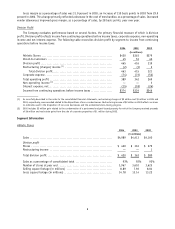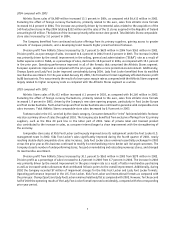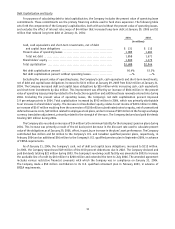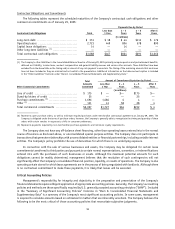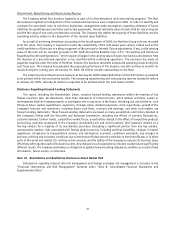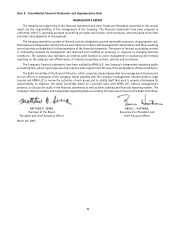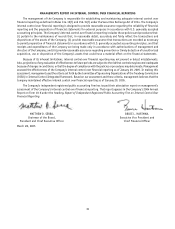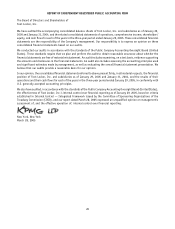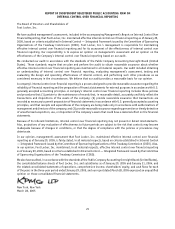Foot Locker 2004 Annual Report Download - page 31
Download and view the complete annual report
Please find page 31 of the 2004 Foot Locker annual report below. You can navigate through the pages in the report by either clicking on the pages listed below, or by using the keyword search tool below to find specific information within the annual report.
Business Combinations
The Company accounts for acquisitions of other businesses in accordance with SFAS No. 141, “Business Combinations”
(“SFAS 141”). SFAS 141 requires that the Company record the net assets of acquired businesses at fair value, and make
estimates and assumptions to determine the fair value of these acquired assets and liabilities. The Company allocates the
purchase price of acquired businesses based, in part, upon internal estimates of cash flows, recoverability and independent
appraisals. Changes to the assumptions used to estimate the fair value could impact the recorded amounts of the assets
acquired and the resultant goodwill.
Merchandise Inventories
Merchandise inventories for the Company’s Athletic Stores are valued at the lower of cost or market using the retail
inventory method. The retail inventory method (“RIM”) is commonly used by retail companies to value inventories at cost
and calculate gross margins by applying a cost-to-retail percentage to the retail value of inventories. The RIM is a system
of averages that requires management’s estimates and assumptions regarding markups, markdowns and shrink, among
others, and as such, could result in distortions of inventory amounts. Judgment is required to differentiate between
promotional and other markdowns that may be required to correctly reflect merchandise inventories at the lower of cost
or market. Management believes this method and its related assumptions, which have been consistently applied, to
be reasonable.
Vendor Reimbursements
In the normal course of business, the Company receives allowances from its vendors for markdowns previously taken.
Vendor allowances are recognized as a reduction in cost of sales in the period in which the markdowns are taken. The effect
of vendor allowances on gross margin, as a percentage of sales, as compared with the corresponding prior year period
was not significant. The Company also has volume-related agreements with certain vendors, under which it receives
rebates based on fixed percentages of cost purchases. These volume-related rebates are recorded in cost of sales when
the product is sold and they contributed 20 basis points to the 2004 gross margin rate.
The Company receives support from some of its vendors in the form of reimbursements for cooperative advertising
and catalog costs for the launch and promotion of certain products. The reimbursements are agreed upon with vendors
for specific advertising campaigns and catalogs. Cooperative income, to the extent that they reimburse specific,
incremental and identifiable costs incurred to date, are recorded in SG&A in the same period as the associated expenses
are incurred. Reimbursements received that are in excess of specific, incremental and identifiable costs incurred to date
are recognized as a reduction to the cost of merchandise and are reflected in cost of sales as the merchandise is sold.
Cooperative reimbursements amounted to approximately 29 percent of total advertising costs in 2004 and approximately
8 percent of catalog costs in 2004.
Impairment of Long-Lived Assets
In accordance with SFAS No. 144, the Company recognizes an impairment loss when circumstances indicate that the
carrying value of long-lived tangible and intangible assets with finite lives may not be recoverable. Management’s policy
in determining whether an impairment indicator exists, a triggering event, comprises measurable operating performance
criteria as well as qualitative measures. If an analysis is necessitated by the occurrence of a triggering event, the Company
uses assumptions, which are predominately identified from the Company’s three-year strategic plans, in determining the
impairment amount. The calculation of fair value of long-lived assets is based on estimated expected discounted future cash
flows by store, which is generally measured by discounting the expected future cash flows at the Company’s weighted-average
cost of capital. Management believes its policy is reasonable and is consistently applied. Future expected cash flows are based
upon estimates that, if not achieved, may result in significantly different results. Long-lived tangible assets and intangible
assets with finite lives primarily include property and equipment and intangible lease acquisition costs.
The Company is required to perform an impairment review of its goodwill, at least annually. The Company has chosen
to perform this review at the beginning of each fiscal year, and it is done in a two-step approach. The initial step requires
that the carrying value of each reporting unit be compared with its estimated fair value. The second step — to evaluate
goodwill of a reporting unit for impairment — is only required if the carrying value of that reporting unit exceeds its
estimated fair value. The fair value of each of the Company’s reporting units exceeded its carrying value as of February 1,
2004. The Company used a combination of a discounted cash flow approach and market-based approach to determine the
15



